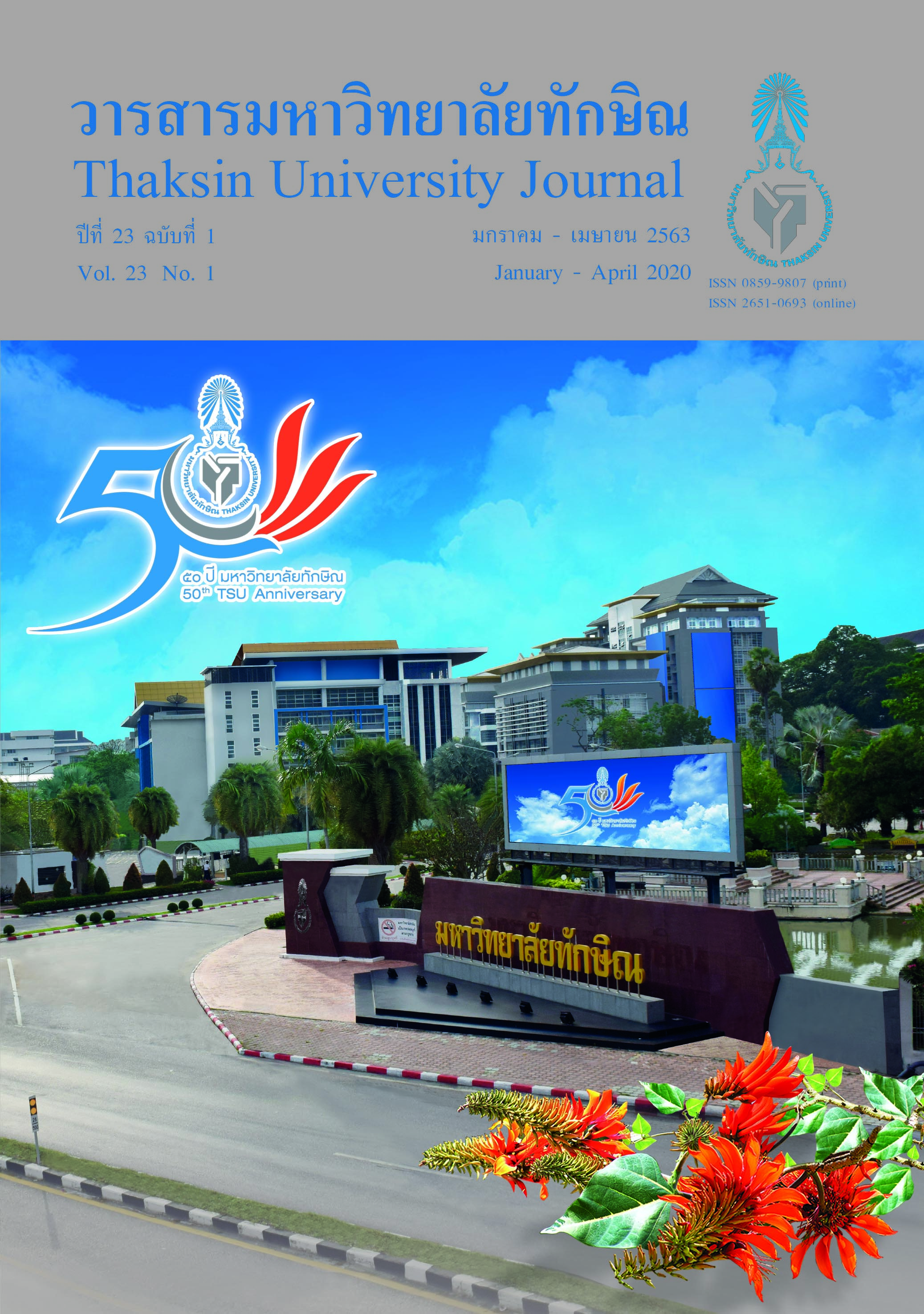Rubber Agroforestry Systems in Mature Plantations in Phatthalung Province, Southern Thailand
Main Article Content
Abstract
Rubber-based agroforestry systems (RAS) can be characterized by the type of trees/shrubs and crops associated with the rubber trees. The present study objective was to identify and describe the RAS in mature plantations existing in Phatthalung province. This province is representative of South Thailand and gathers many farmers with agroforestry practices. The methodology for data collection combined focus group discussions with 5 groups and individual interviews with 56 farmers using a semi-structured questionnaire and farmer’s field survey for 44 RAS plots. The results showed an important diversity of the RAS. Seven types of agroforestry systems were identified with 20 species of fruit trees, 14 species of timber trees and 6 species of pluri annual local crops. The analysis of the timeline to plant rubber and intercrops showed some flexibility for the establishment of the RAS. The associated crops and the sometimes-long existence of these RAS indicate that they could be an interesting alternative to monoculture for the farmers to improve resilience and not rely only on one crop. However, before recommending these RAS, additional research is needed to better characterize the impact of these systems in particular on crop yield and soil biodiversity quality.
Article Details

This work is licensed under a Creative Commons Attribution-NonCommercial-NoDerivatives 4.0 International License.
References
Rubber Research Institute of Thailand (RRIT). (2007). Rubber: A technical bulletin. Bangkok: Department of Agriculture, Ministry of Agriculture and Cooperatives.
Research Institute of Thailand (RRIT). (2010). The rubber development strategy 2009-2014. Bangkok: Department of Agriculture, Ministry of Agriculture and Cooperatives.
Office of Agricultural Economics (OAE). (2003-2015). Agricultural statistics of Thailand 2002-2014. Bangkok: Ministry of Agriculture and Cooperatives.
Jongrungrot, V., Thungwa, S., & Snoeck, D. (2014). Tree-crop diversification in rubber plantations to diversity sources of income for small-scale rubber farmers in Southern Thailand. Bois et Forêts des Tropiques, 321, 21–32.
Stroesser, L., Penot, E., Michel, I., Tongkaemkaew U., & Chambon, B. (2018). Income diversification for rubber farmers through agroforestry practices: how to withstand rubber price volatility in Phatthalung Province, Thailand. Revue Internationale des Études du Développement, 235, 117–145.
Torquebiau, E.F. (2000). A renewed perspective on agroforestry concepts and classification. Comptes Rendus de l’Académie des Sciences-Series III-Sciences de la Vie, 323(11), 1009–1017.
Nair, P.K.R. (1985). Classification of agroforestry systems. Agroforestry Systems, 3(2), 97–128.
Warren-Thomas, E., Nelson, L., Juthong, W., Bumrungsri, S., Brattström, O., Stroesser, L.,… Dolman, P.M. (2020). Rubber agroforestry in Thailand provides some biodiversity benefits without reducing yields. Journal of Applied Ecology, 57 (1), 17-30. DOI: https://doi.org/ 10.1111/1365-2664.13530.
Simien, A., & Penot, E. (2011). Current evolution of smallholder rubber-based farming systems in Southern Thailand. Journal of Sustainable Forestry, 30(3), 247–260. DOI: https://doi.org/10.1080/10549811.2011.53093.
Inyod, H., Tongkaemkaew, U., & Phitthayaphinant, P. (2020). Rubber agroforestry systems in Trang province. Khon Kaen Agriculture Journal, 48 (SUPPL. 1), 385–392.
Penot, E. (2001). Stratégies paysannes et évolution des savoirs: l’hévéaculture agro-forestière indonésienne. Thèse de doctorat. Université Montpellier I.
Wibawa, G., Joshi, L., Van Noordwijk, M., & Penot, E. (2007). Rubber based agroforestry systems (RAS) as alternatives for rubber monoculture system. 1-22. In The Intenational Rubber Research and Development Board (IRRDB) Annual Meeting and Conference 2006, November 13-17, 2006, Ho Chi Minh City: Vietnam.
Jongrungrot, V. (2014). The Economic efficiency and social security of smallholder farming system which practies associate crops in rubber plots in southern Thailand. Doctor Dissertation. Prince of Songkla University.
Rodrigo, V.H.L, Stirling, C.M., Silva, T.U.K., & Pathirana, P.D. (2005). The growth and yield of rubber at maturity is improved by intercropping with banana during the early stage of rubber cultivation. Field Crops Research, 91(1), 23–33.
Tongkaemkaew, U., Sukkul, J., Sumkhan, N., Panklang, P., Brauman, A., & Ismail, R. (2018). Litterfall, litter decomposition, soil macrofauna, and nutrient content in rubber monoculture and rubber based agroforestry plantations. Forest and Society, 2(2), 138–149.
Torquebiau, E., & Penot, E. (2006). Ecology versus economics in tropical multistata agroforest. In B.M. Kumar & P.K.R. Nair (Eds.). Tropical Homegardens: A Time-Tested Example of Sustainable Agroforestry. 269–282. Dordrecht, Netherlands: Springer.
Sinclair, F. (1999). A general classification of agroforestry practice. Agroforestry Systems, 46(2),161–180.
McGinty, M.M., Swisher, M.E., & Alavalapati, J. (2008). Agroforestry adoption and maintenance: self-efficacy, attitudes and socio-economic factors. Agroforestry Systems, 73(2), 99–108.


